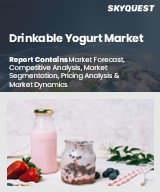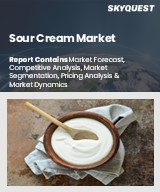
|
시장보고서
상품코드
1491711
진 시장 평가 : 유형별, 알코올 도수별, 가격대별, 유통 채널별, 지역별, 기회, 예측(2017-2031년)Gin Market Assessment, By Type, By ABV, By Price Range, By Distribution Channel, Region, Opportunities and Forecast, 2017-2031 |
||||||
세계 진 시장 규모는 2024-2031년 예측 기간 동안 5.2%의 CAGR로 2023년 154억 7,000만 달러에서 2031년 235억 4,000만 달러로 성장할 것으로 예상됩니다. 이 시장은 지난 몇 년 동안 중상위권의 성장세를 보이고 있습니다. 세계 진 시장은 크래프트 진과 장인정신이 깃든 진의 인기가 높아짐에 따라 성장할 것으로 예상됩니다. 소규모 증류주 제조업체들이 번창하고 있으며, 대부분 지역에서 생산되는 독특한 진은 진품 지향과 장인정신을 추구하는 소비자들에게 어필하고 있습니다. 이러한 크래프트 진은 종종 식물 원산지와 전통적 제조 방식을 강조하여 고품질의 독특한 제품을 원하는 소비자의 공감을 불러일으키고 있습니다. 또한, 여성들의 진 소비가 증가하고 있는 것도 세계 진 시장의 성장을 강화하는 큰 원동력이 되고 있습니다.
RTD(Ready To Drink) 및 고급 주류 시장이 급성장하고 있습니다. 이러한 간편하고 미리 혼합된 진 칵테일은 빠르게 변화하는 라이프스타일 속에서 간편한 선택을 원하는 소비자와 오랜 시간 준비할 필요 없이 이동 중이나 집에서 즐길 수 있는 고품질 음료를 원하는 소비자를 만족시키고 있으며, RTD 분야에서는 다양한 맛과 스타일이 등장하고 있습니다.
이 보고서는 세계 진 시장에 대해 조사했으며, 시장 개요와 함께 유형별, 알코올 도수별, 가격대별, 유통 채널별, 지역별 동향, 시장 진입 기업 개요 등을 제공합니다.
목차
제1장 조사 방법
제2장 프로젝트 범위와 정의
제3장 주요 요약
제4장 고객의 소리
제5장 세계의 진 시장 전망, 2017-2031년
- 시장 규모와 예측
- 유형별
- 알코올 도수별
- 가격대별
- 유통 채널별
- 지역별
- 기업별 시장 점유율(%), 2023년
제6장 세계의 진 시장 전망, 지역별, 2017-2031년
- 북미
- 유럽
- 아시아태평양
- 남미
- 중동 및 아프리카
제7장 시장 매핑, 2023년
제8장 거시적 환경과 산업 구조
- 수요 공급 분석
- 수출입 분석
- 밸류체인 분석
- PESTEL 분석
- Porter's Five Forces 분석
제9장 시장 역학
제10장 주요 진출 기업 상황
제11장 가격 분석
제12장 사례 연구
제13장 주요 진출 기업 전망
- Diageo plc
- Pernod Ricard S.A.
- Suntory Holdings Limited
- Bacardi Limited
- Davide Campari-Milano N.V.
- William Grant & Sons Ltd
- The East India Company LTD
- San Miguel Corporation(Ginebra San Miguel, Inc.)
- Radio Khatan Limited
- The Sustainable Spirit Co.
제14장 전략적 제안
제15장 문의와 면책사항
ksm 24.06.14Global gin market is projected to witness a CAGR of 5.2% during the forecast period 2024-2031, growing from USD 15.47 billion in 2023 to USD 23.54 billion in 2031. The market has experienced medium to high growth in the past few years. The global gin market is expected to grow due to the rise in popularity of craft and artisanal gins. Small spirit manufactures are flourishing, often unique, locally produced gins that appeal to consumers seeking authenticity and craftmanship. These craft gins often highlight the origin of their botanicals and traditional methods used in their production, which resonates with consumers looking for high-quality and unique products. Also, the rising consumption of gin among women is gain popularity and is a major driving factor for strengthening the global gin market growth.
The market for ready-to-drink and luxury spirits has expanded rapidly. These convenient, pre-mixed gin cocktails cater to consumers looking for easy options in their fast-paced lifestyles, high quality drinks that can be enjoyed on the go or at home without the need for extended preparations. The ready-to-drink segment has introduced a variety of flavors and styles.
According to the Distilled Sprit Council of the United States (DISCUS) annual report states that in 2023, over the past 14 years spirits market share totaled more than 42% and in 2023 ready-to-drink products sales hiked at 26.8%, which is fastest-growing spirits category by revenue.
Also, the demand for luxury spirits has influenced the gin market. Premium and super-premium gins features and eye-catching packaging have found a strong consumer base, driving the overall market growth.
Innovative Flavors and Product Diversification
The introduction of innovative flavors and product diversification significantly influences the gin market. Traditionally, gin has been associated with its classic juniper-forwards taste. However, recent trends show a shift towards more adventurous and varied flavor profiles. Spirit manufacturers are experiencing a wide range of botanicals and ingredients, creating unique and novel gins that cater to evolving consumer preferences. These innovative flavors range from fruity and floral notes to spiced and herbal undertones. Some gins incorporate unusual ingredients such as rose petals, cucumber, or exotic fruits, which provide a distinct taste experience.
For instance, in 2023, Empress 1908 Indigo Gin launched a new gin for spring 'Empress 1908 Elderflower Rose Gin'. The new flavored gin is crafted and distilled with nine botanicals infusions which includes rose petals, elderflower, juniper berries, orange peel, lavender, cinnamon, black carrot, and orris root.
The experimentation appeals to traditional consumers and attracts new consumers who might not have consumed gin. Product diversification in the global gin market includes the introduction of limited-edition releases, seasonal gins, and collaboration with other brands. Furthermore, the diversification extends to packaging and branding, with many gins packaging which seems to attract, growing their interest in premium gin products.
For instance, in April 2024, Ocean Conservation Trust released the second limited-edition gin bottle, 'Ocean Edition', in partnership with Plymouth Gin. The color is baked into the glass and both the label and bottle are made using recycled and 100% recyclable materials.
These offerings generate excitement and provide a sense of exclusivity, encouraging consumers to try new products. Combining innovative flavors and product diversification allows gin brands to differentiate themselves in a competitive market. By continuously introducing new products, they can meet consumers' different tastes and maintain their demands. This approach helps expand the market reach and drive market growth.
Health-Conscious Consumers Seeking Low-Calorie Options
People are increasingly looking for alcoholic beverages that align with their wellness goals as they become mindful of their diet and health. Gin, which is known for its relatively low-calorie content as compared to other spirits, suits well into this trend. The standard serving of gin is mixed with low-calorie or sugar-free mixers, which can be a better option as compared to many traditional cocktails. This makes it an attractive choice for those who want to enjoy a drink without consuming more calories. Gin brands are responding to these demands of consumers by marketing their products as healthier alternatives, emphasizing the lower calorie content in their promotional materials. In addition, many gins are distilled with natural botanicals, which appeals to consumers who are seeking less processed and more natural options. The trend towards 'clean drinking' is pushing brands to innovate gins that taste great and have health-friendly properties. Some brands are introducing specific low-calorie or light-gin varieties.
These products are designed to meet the requirements of health-concerned alcohol consumers, often featuring reduced alcohol content and fewer calories while maintaining the characteristic flavors of gin. Therefore, the rising trend of health-conscious consumers are seeking low-calorie options, notably impacting global gin market growth.
Asia-Pacific is Anticipated to be the Fastest-Growing in the Global Gin Market
Asia-Pacific is expected to be the fastest-growing region in the global gin market. The region's growth is driven by factors such as the urban and young population's interest in western drinking cultures, including cocktails and spirits. The Millennial and Gen-Z populations are more open to experimenting with new flavors and are influenced by global food and beverage trends. The popularity of social media and digital marketing fuels interest, as spirits manufactures are exposed to gin-related content and mixology trends from around the world. Increasing disposable income in countries such as India, China, and Japan indicate that more consumers can afford premium and high-quality products, including gin.
In addition, the hospitality and tourism industries in the region are booming, with different new hotels, bars, and restaurants opening. Moreover, the rising trend of e-commerce platforms in the region makes it easier for consumers to purchase gin online, expanding its market reach. Collectively, the combination of increasing wealth, expanding hospitality, and the rise of the e-commerce sector is expected to contribute to the rapidly growing market for gin, propelling the market growth.
Future Market Scenario (2024 - 2031F)
Working on innovative marketing strategies merged with digital platforms, which provide immersive experiences such as virtual tasting and distillery tours, engaging spirit consumers, and building brand loyalty recognition. It also helps strengthen market growth through the ease of product availability.
A rising trend in mixology involves bar tenders experimenting with gin in various classic and new cocktails, recopying a wide range of flavors as per customer requirements, which fits the local tastes and cultural preferences, fueling the demand for gin in market growth.
Key Players Landscape and Outlook
Continuous innovation by the key players characterizes the competitive landscape of the global gin market. The market is dominated by major players with their well-known brands. These companies and brands lead through extensive distribution networks and product portfolios, strong brand recognition, product launch, acquisition, and brand evolution, ensuring a strong global presence.
For instance, in December 2023, Tanqueray (Diageo plc owned brand) introduced two novel variants to their classic dry gin series and expanded their portfolio by adding Tanqueray Rangpur and Tanqueray Malacca with their unique citrus-infused profile.
The increasing popularity of gin in emerging markets, especially in Asia and South America, offers significant expansion opportunities. Also, the ongoing trend of premiumization makes consumers choose for higher-quality standard products. Gin manufacturers are concerned with supply chain resilience, product quality, manufacturing locally to minimize operational cost, and variety which is likely to define the industry's future. Collaborations and developing technologies are projected to increase competition in the fast-paced market.
Table of Contents
1. Research Methodology
2. Project Scope and Definitions
3. Executive Summary
4. Voice of Customer
- 4.1. Demographics (Age/Cohort Analysis-Baby Boomers and Gen X, Millennials, Gen Z; Gender. Income-Low, Mid, and High; Geography; Nationality; etc.)
- 4.2. Market Awareness and Loyalty
- 4.3. Factors Considered in Purchase Decision
- 4.3.1. Flavor
- 4.3.2. Alcohol Content
- 4.3.3. Brand
- 4.3.4. Price
- 4.3.5. Type
- 4.3.6. Origin
- 4.3.7. Aging
- 4.3.8. Offers and Discounts
- 4.4. Purpose of Purchase
- 4.5. Medium of Purchase
- 4.6. Frequency of Purchase
- 4.7. Recommendations From Doctors
- 4.8. Role of Brand Ambassador or Influencer Marketing on Product/Brand Absorption
5. Global Gin Market Outlook, 2017-2031F
- 5.1. Market Size & Forecast
- 5.1.1. By Value
- 5.1.2. By Volume
- 5.2. By Type
- 5.2.1. London Dry
- 5.2.2. Old Tom
- 5.2.3. Plymouth
- 5.2.4. Genever
- 5.2.5. Others
- 5.3. By ABV
- 5.3.1. Below 40%
- 5.3.2. 40% and Above
- 5.4. By Price Range
- 5.4.1. Mid-Range
- 5.4.2. Premium
- 5.4.3. Super-Premium
- 5.5. By Distribution Channel
- 5.5.1. On-Trade
- 5.5.1.1. HoReCa
- 5.5.1.2. Bars and Clubs
- 5.5.1.3. Others
- 5.5.2. Off-Trade
- 5.5.2.1. Specialty Stores
- 5.5.2.2. Hypermarkets and Supermarkets
- 5.5.2.3. Online
- 5.5.2.4. Others
- 5.5.1. On-Trade
- 5.6. By Region
- 5.6.1. North America
- 5.6.2. Europe
- 5.6.3. Asia-Pacific
- 5.6.4. South America
- 5.6.5. Middle East and Africa
- 5.7. By Company Market Share (%), 2023
6. Global Gin Market Outlook, By Region, 2017-2031F
- 6.1. North America*
- 6.1.1. Market Size & Forecast
- 6.1.1.1. By Value
- 6.1.1.2. By Volume
- 6.1.2. By Type
- 6.1.2.1. London Dry
- 6.1.2.2. Old Tom
- 6.1.2.3. Plymouth
- 6.1.2.4. Genever
- 6.1.2.5. Others
- 6.1.3. By ABV
- 6.1.3.1. Below 40%
- 6.1.3.2. 40% and Above
- 6.1.4. By Price Range
- 6.1.4.1. Mid-Range
- 6.1.4.2. Premium
- 6.1.4.3. Super-Premium
- 6.1.5. By Distribution Channel
- 6.1.5.1. On-Trade
- 6.1.5.1.1. HoReCa
- 6.1.5.1.2. Bars and Clubs
- 6.1.5.1.3. Others
- 6.1.5.2. Off-Trade
- 6.1.5.2.1. Specialty Stores
- 6.1.5.2.2. Hypermarket and Supermarkets
- 6.1.5.2.3. Online
- 6.1.5.2.4. Others
- 6.1.5.1. On-Trade
- 6.1.6. United States*
- 6.1.6.1. Market Size & Forecast
- 6.1.6.1.1. By Value
- 6.1.6.1.2. By Volume
- 6.1.6.2. By Type
- 6.1.6.2.1. London Dry
- 6.1.6.2.2. Old Tom
- 6.1.6.2.3. Plymouth
- 6.1.6.2.4. Genever
- 6.1.6.2.5. Others
- 6.1.6.3. By ABV
- 6.1.6.3.1. Below 40%
- 6.1.6.3.2. 40% and Above
- 6.1.6.4. By Price Range
- 6.1.6.4.1. Mid-Range
- 6.1.6.4.2. Premium
- 6.1.6.4.3. Super-Premium
- 6.1.6.5. By Distribution Channel
- 6.1.6.5.1. On-Trade
- 6.1.6.5.1.1. HoReCa
- 6.1.6.5.1.2. Bars and Clubs
- 6.1.6.5.1.3. Others
- 6.1.6.5.2. Off-Trade
- 6.1.6.5.2.1. Specialty Stores
- 6.1.6.5.2.2. Hypermarket and Supermarkets
- 6.1.6.5.2.3. Online
- 6.1.6.5.2.4. Others
- 6.1.6.5.1. On-Trade
- 6.1.6.1. Market Size & Forecast
- 6.1.7. Canada
- 6.1.8. Mexico
- 6.1.1. Market Size & Forecast
All segments will be provided for all regions and countries covered
- 6.2. Europe
- 6.2.1. Germany
- 6.2.2. France
- 6.2.3. Italy
- 6.2.4. United Kingdom
- 6.2.5. Russia
- 6.2.6. Netherlands
- 6.2.7. Spain
- 6.2.8. Turkey
- 6.2.9. Poland
- 6.3. Asia-Pacific
- 6.3.1. India
- 6.3.2. China
- 6.3.3. Japan
- 6.3.4. Australia
- 6.3.5. Vietnam
- 6.3.6. South Korea
- 6.3.7. Indonesia
- 6.3.8. Philippines
- 6.4. South America
- 6.4.1. Brazil
- 6.4.2. Argentina
- 6.5. Middle East and Africa
- 6.5.1. Saudi Arabia
- 6.5.2. UAE
- 6.5.3. South Africa
7. Market Mapping, 2023
- 7.1. By Type
- 7.2. By ABV
- 7.3. By Price Range
- 7.4. By Distribution Channel
- 7.5. By Region
8. Macro Environment and Industry Structure
- 8.1. Demand Supply Analysis
- 8.2. Import Export Analysis
- 8.3. Value Chain Analysis
- 8.4. PESTEL Analysis
- 8.4.1. Political Factors
- 8.4.2. Economic System
- 8.4.3. Social Implications
- 8.4.4. Technological Advancements
- 8.4.5. Environmental Impacts
- 8.4.6. Legal Compliances and Regulatory Policies (Statutory Bodies Included)
- 8.5. Porter's Five Forces Analysis
- 8.5.1. Supplier Power
- 8.5.2. Buyer Power
- 8.5.3. Substitution Threat
- 8.5.4. Threat from New Entrant
- 8.5.5. Competitive Rivalry
9. Market Dynamics
- 9.1. Growth Drivers
- 9.2. Growth Inhibitors (Challenges and Restraints)
10. Key Players Landscape
- 10.1. Competition Matrix of Top Five Market Leaders
- 10.2. Market Revenue Analysis of Top Five Market Leaders (By Value, 2023)
- 10.3. Mergers and Acquisitions/Joint Ventures (If Applicable)
- 10.4. SWOT Analysis (For Five Market Players)
- 10.5. Patent Analysis (If Applicable)
11. Pricing Analysis
12. Case Studies
13. Key Players Outlook
- 13.1. Diageo plc
- 13.1.1. Key Management Personnel
- 13.1.2. Products and Services
- 13.1.3. Financials (As reported)
- 13.1.4. Key Market Focus and Geographical Presence
- 13.1.5. Recent Developments
- 13.2. Pernod Ricard S.A.
- 13.3. Suntory Holdings Limited
- 13.4. Bacardi Limited
- 13.5. Davide Campari-Milano N.V.
- 13.6. William Grant & Sons Ltd
- 13.7. The East India Company LTD
- 13.8. San Miguel Corporation (Ginebra San Miguel, Inc.)
- 13.9. Radio Khatan Limited
- 13.10. The Sustainable Spirit Co.
Companies mentioned above DO NOT hold any order as per market share and can be changed as per information available during research work.



















